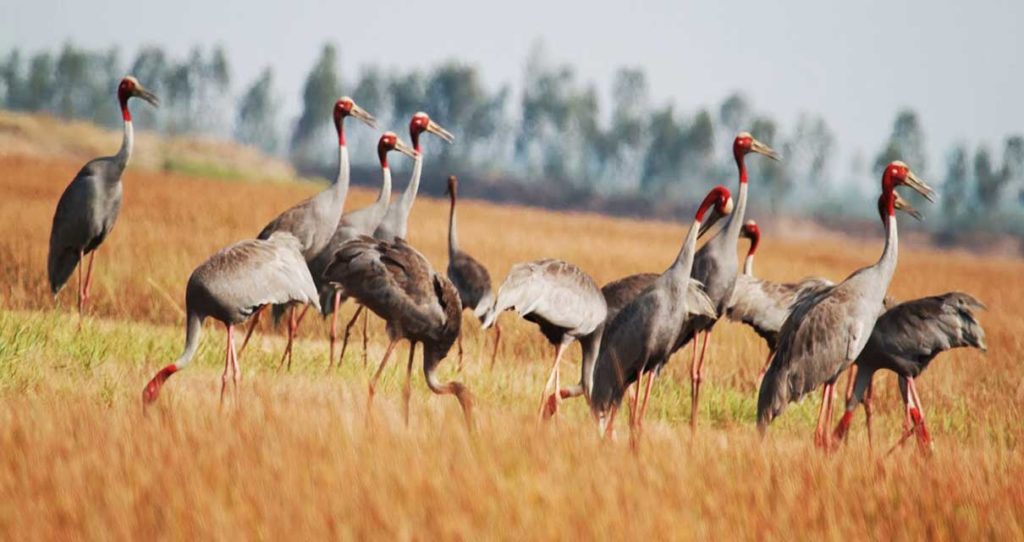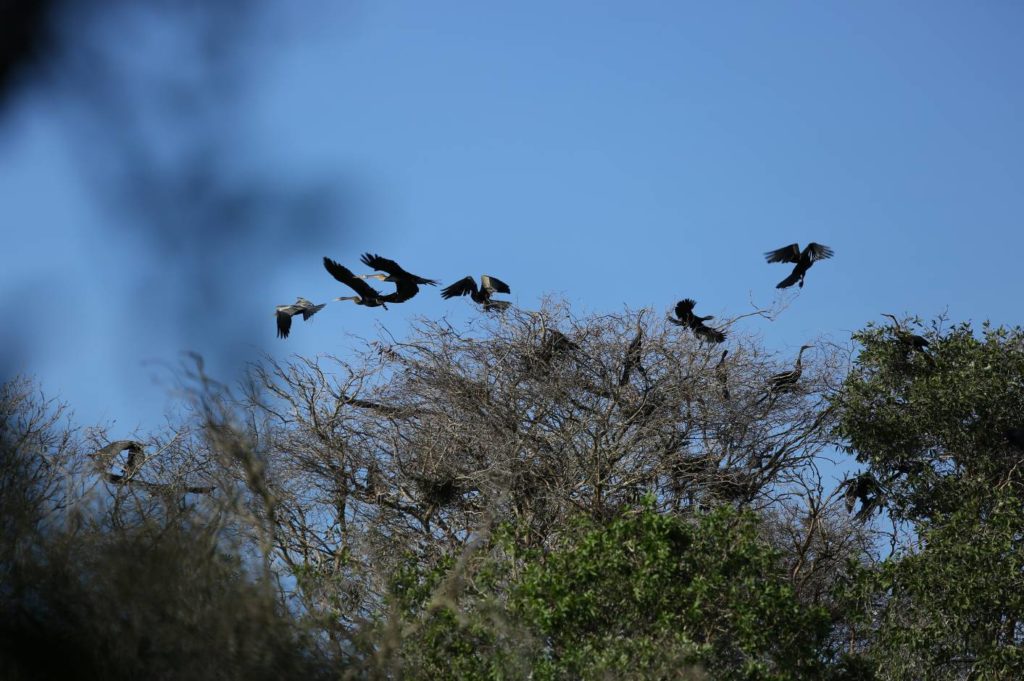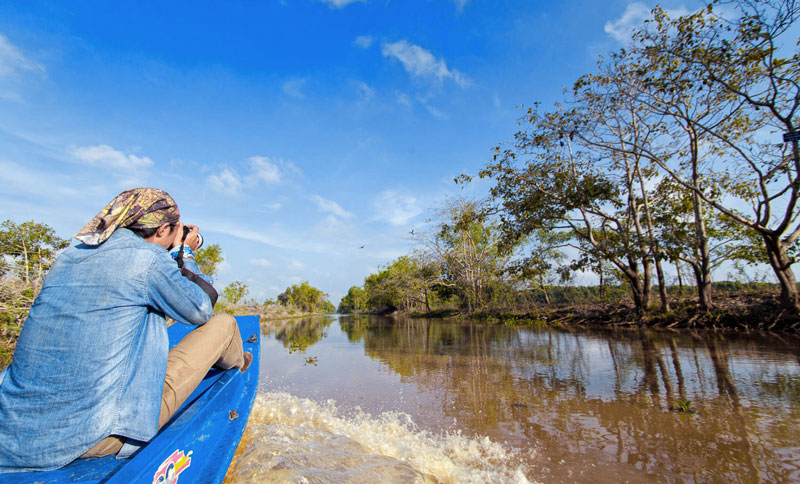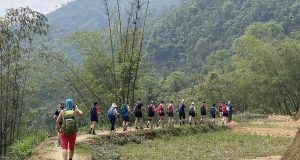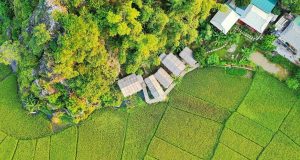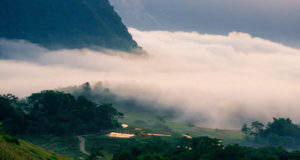Tram Chim National Park (also called Dong Thao Muoi or Tram Chim Tam Nong) is located in Dong Thap Province of the Mekong Delta region. The protected park has been famous for the “sarus cranes” or “Grus antigone” (popularly called red-crowned cranes) which gather on the rice fields for food, creating a beautiful spectacle. These cranes are listed in the IUCN Red List of Threatened Species, confirming the fact that Tram Chim is an attractive place to preserve and visit. Let’s follow Vietnam Travel Guide !
Scientific Information about Tram Chim National Park
- Tram Chim National Park is located in Tam Nong District, Dong Thap Province. Its map coordinate is as follows: 10o40’ – 10o47’ N, 105o26’ – 105o36’ E
- It has an area of 7.588 hectares.
- Its terrace belongs to the reed fields of the Mekong Delta ecological agriculture region.
- Tram Chim was established in 1986 by the Dong Thap Province People’s Committee as the “Sarus Crane Natural Reserve” aiming to protect the “Grus antigone” species.
- Between the mid-May 1991 and December 1992, the investment project for Tram Chim Nature Reserve was initiated.
- On February 2nd, 1994, according to the Decision No. 47/TTg of the Prime Minister attached to the Circular No. 4991/KGVX, the Tram Chim National Nature Reserve was officially established. The preserved area was called “Tram Chim Tam Nong” (Ministry of Agriculture and Rural Development, 1997, Pham Trong Thinh and Nguyen Chi Thanh, 2000) and included 7.500 hectares.
- In 1998, the investment project of this Nature Reserve was modified, giving it an area of 7.588 hectares, including the Strict Protection Zone of 6.889 hectares, Ecological Rehabilitation Zone of 653 hectares, and Administrative Service Subdivision of 46 hectares.
- On December 29th, 1998, Tram Chim became the National Park in pursuant to the Decision No. 253/1998/QĐ-TTg of the Prime Minister.
Biology and Conservation Topics in Tram Chim Tam Nong
The National Park is diverse in kinds of vegetation including the seasonally inundated grasslands, Melaleuca cajuput forests, and lagoons. In Tram Chim Tam Nong, there are five major wild grasslands, and the most dominated ones are of “Eleocharis dulcis” and “Oryza rufipogon” (“Lua ma” or “ghost rice”). Other grasslands have “Eleocharis ochrostachys”, “Panicum repens”, “Ischaemum rugosum” and “Vossia cuspidata.” Another important vegetation is the lotus ponds of Nelumbo nucifera, Nymphaea nouchali, N. pubescens, and N. tetragona.
The areas recorded a large number of the big water-birds migrating during the winter. Also, the region welcomes the “Grus antigone” cranes gathering for food during the dry season. What’s more, Tram Chim National Park in Tam Nong is inhabited by some other endangered birds namely Houbaropsis bengalensis, Anhinga melanogaster, Leptoptilos javanicus, Mycteria leucocephala, Ploceus hypoxanthus, Nettapus coromandelianus, Rostratula benghalensis, and Hydrophasianus chirurgus.
Regarding the matter of conservation, Tram Chim Park demands strict protection due to the high threats. Some local people invaded the region to hunt species and collect firewood. Furthermore, surrounding the National Park is the rice cultivation area in which people use the soil in an unstable way. This causes the negative influences on the wetland ecosystems, namely the pollution and changing the natural water level of the region. To deal with the conservation matters, solutions are to adjust the water level to make it suitable for the red-crowned cranes. This solution brought the positive results in 2001.
Local Residence, Culture, and Tourism in Tram Chim
The countryside life of residents living around Tram Chim Tam Nong depends on agriculture and the exploitation of local resources (firewood, fish, grass, etc.). This leads to the depletion of the resources around and even inside the park. Regardless of these downsides, people in this Mekong Delta region are very friendly as well as preserving their agricultural lifestyle and culture.
Traveling to Tram Chim National Park, tourists will enjoy sightseeing the green landscapes of the canals, cajuput forests, rice fields, and lotus ponds. Particularly between December and May, this place is migrated by around 60% of the red-crowned cranes, the tallest birds in the world. This tourist attraction offers some interesting activities such as a boat trip to the cajuput forests and grasslands, bird watching, eating the Mekong Delta food, etc. The spacious wetland covering a diversity of animals and plants is open for all visitors. Note that around ¼ of the total number of birds in Vietnam inhabit in this protected area, and some are listed in the Red Book of Vietnam, and even of the world. It takes about a 6-hour drive from Ho Chi Minh City to Tram Chim Tam Nong.
For tours to Tram Chim Tam Nong, the best time is the dry season (between December and May). Especially from February to May is when to meet the sarus cranes with the red head, tall feet, and silky long broad wings. Groups of the red-crowned cranes create the very beautiful objects on the green rice fields for sightseeing and photography. The view becomes best in the red light at sunset when the sarus cranes seem to offer the most attractive dance performances. What’s more, between September and October is the season of breeding for birds, when you can view the nest of birds hanging on the branches of Melaleuca, the bird-mothers feeding the hatches, and the little birds practicing flying.
After checking in and getting your tickets, be prepared for a motorboat trip on the canals to pass the lotus ponds, the 20m Vong Canh tower, and then the wet rice fields where the birds are gathering. Appreciate your opportunities to take pictures with the white or pink lotuses and capture the panoramic views of the wetland as well as the rich wildlife. After the boat trip is the happy meal with the folksy dishes of the Mekong Delta land. You can expect to taste the eel soup porridge (Lau Chao Luon), fish soup with Siamese mud carp and common sesban (Lau Ca Linh Bong Dien Dien), field mice grilled in the terracotta jar (Chuot Dong Nuong Lu), fish stew with water lily (Bong Sung Mam Kho), etc.
Visit Tram Chim National Park Dong Thap, you’ll be glad about this green and wild escape to a bustle-free yet friendliness-full land.
 Vietnam Travel Guide Backpacking and Individual Travel Blog
Vietnam Travel Guide Backpacking and Individual Travel Blog

